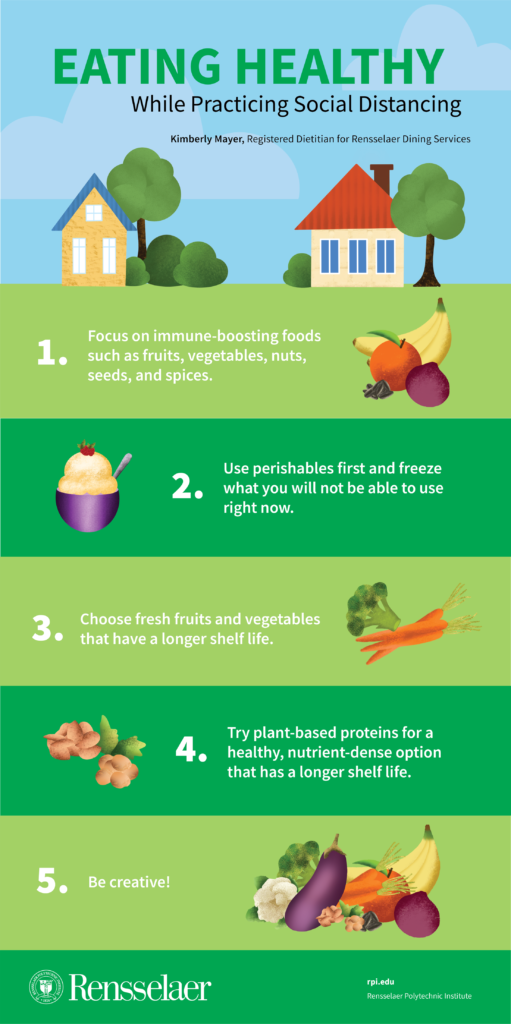By Kimberly Mayer, Registered Dietitian for Rensselaer Dining Services
In the midst of the COVID-19 outbreak, as we are all trying to navigate new routines and keep our lives as normal as possible, I’ve realized that this is also an important time to focus on our health. Now more than ever, we need to make sure we are choosing foods that are nutritious and boost our immune systems. How are we able to do this while staying home and not venturing out to the grocery store as often? How can we do this while not living off pasta and jarred sauce? Here are some tips:
1. Focus on immune-boosting foods such as fruits, vegetables, nuts, seeds, and spices. These foods provide antioxidants that help our bodies fight off free radicals and keep us healthy. Frozen fruits and vegetables provide all of the same nutrients as the fresh version and will last much longer. Try making a smoothie with frozen mango, frozen banana, oatmeal, peanut butter, milk, spinach, cinnamon, and spirulina (optional). It will provide immune-boosting vitamin C, calcium, protein, and fiber (and taste delicious).
2. Use perishables first and freeze what you will not be able to use right now. Take a look at what you have on hand and build meals around the perishable foods. I like to peel my overripe bananas and freeze them to use in smoothies or to make healthy homemade ice cream! You can do the same with fresh berries and fruit that is too ripe to eat. Wash and cut off stems and freeze them to use in baked goods, or as a topping for your yogurt or oatmeal. Roast fresh vegetables with a little olive oil and spices and blend them into a soup or eat them with chicken sausage over quinoa for a delicious dinner.
3. Choose fresh fruits and vegetables that have a longer shelf life. Spaghetti squash, butternut squash, sweet potatoes, carrots, cauliflower, and broccoli are all loaded with vitamins, minerals, and fiber, and will last longer than other vegetables. Instead of having pasta, try roasting spaghetti squash. One cup has only 40 calories and loads of fiber and vitamin C. It can be topped with your favorite sauce and meatballs or beans.
4. Try plant-based proteins for a healthy, nutrient-dense option that has a longer shelf life. If you have never tried plant-based proteins, now may be a good opportunity. Some of my favorites are chickpeas, beans (canned or dried), lentils, nuts, nut butter, seeds (totally underestimated), edamame, and tofu. You can roast chickpeas with spices to make a delicious snack or a topping for a buddha bowl, make a lentil and vegetable stew, add seeds to your yogurt or oatmeal, or make greens and beans with white beans and spinach. When you use canned anything make sure that you rinse it well to get rid of some of the extra sodium.
5. Be creative. I love to look online for new healthy recipes and now is the time to try something new. Some of my suggestions are cauliflower steak with butter beans and pesto, baked eggplant rollatini, roasted cauliflower and chickpea soup, buffalo chicken burgers, sweet potato and black bean bowls, flourless peanut butter oatmeal cookies, carrot fries, chocolate peanut butter banana blender muffins, and energy bites. Most of these recipes can be found on Pinterest but there are many delicious healthy recipes from all over the internet.




